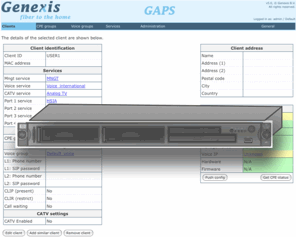- Description
- Downloads
GAPS is the Genexis Automatic Provisioning System, the system that Genexis has developed as part of its managed CPE concept. In short, GAPS performs the function of managing the settings of the CPEs in the network. For instance, GAPS is used to set telephone numbers, VLANs, takes care of firmware upgrades, etc. When designing a CPE, choices are continuously made between obtaining maximum functionality and reducing the cost-of-ownership. Genexis has taken the CPE management into this equation. In optimising the remote management of the CPE, Genexis has found that it makes sense to extend the management capabilities beyond the CPE itself. Instead of just managing the CPE as a standalone box, Genexis provides a central GAPS server that enhances the management functionality. In a sense, this concept places some of the CPE intelligence in a central location, enabling a more powerful CPE management. GAPS is not a replacement for network management, rather it is a tool or interface between the CPE and the network operator or network management system. In a sense, GAPS is piece of the CPE intelligence, except that it is located centrally within the network, rather than spread out over the many individual CPEs. GAPS can easily be integrated with other management systems that may already exist (such as billing systems or other OSS/BSS). This is allowed through the use of various interfaces and protocols such as: HTTP (web-based user interface) MySQL (direct database access) SOAP (CPE provisioning) SNMP (server management) Other interfaces may be implemented upon request. Typically, integration is done through the use of SOAP, but it is also possible to have direct access to the GAPS database. This allows, for example, to create highly customized reports based on available data. One use of such reports is to verify the currently provisioned services on all clients versus the information in a billing system, so that the operator can ensure that there are no clients who are receiving free service they are not entitled to.


